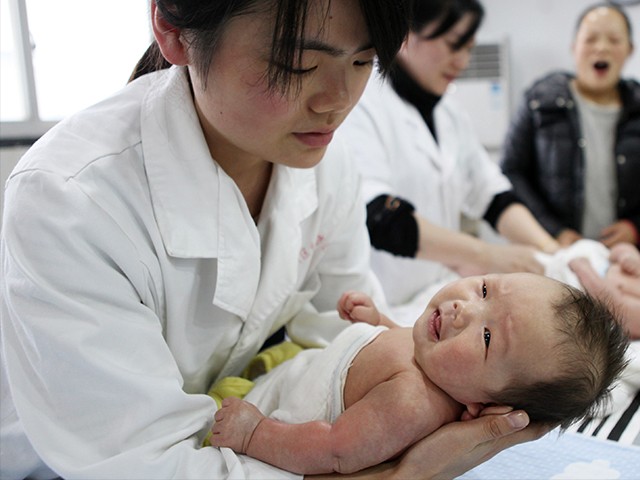Chinese censors on Wednesday quickly deleted an article in a maternity-related news service that leaked plummeting birth rate data for 2023, revealing China’s population crisis is even worse than the regime has previously admitted.
The article in question appeared on the Tieba social media platform, which is run by online giant Baidu, and was quoted by a news service called Mother and Infant Daily News.
Tieba, a word that means “let’s post articles,” is a huge collection of forums similar to Reddit in concept. Baidu describes it as the largest online community in the world due to its vast number of users.
An account in Tieba called City Data posted data on Wednesday that said 7.88 million babies were born in 2023, which was a stunning 1.68 million less than 2022’s total. Measured against China’s 11 million deaths, this meant the national population declined by a net 3.12 million.

This photograph taken on December 15, 2016, shows a nurse holding a baby at an infant care centre in Yongquan, in Chongqing municipality, in southwest China (STR/AFP/Getty Images).
Within a matter of hours, Chinese censors tracked down and deleted the City Data post on Tieba.
Radio Free Asia (RFA) found the quick censorship curious since the Chinese Communist Party might be touchy about discussing its population crisis, but declining birth rates are no great secret, and City Data’s numbers were in line with projections made by prominent demographers. A journal called China Philanthropist made a prediction of fewer than eight million births in May that turned out to be highly accurate.
RFA pointed out that the factors contributing to these low fertility rates are also clear, and the Chinese Communist Party does not usually censor discussions of them:
Meanwhile, the number of Chinese couples tying the knot for the first time has fallen by nearly 56% over the past nine years, the financial magazine Yicai quoted the 2023 China Statistical Yearbook as saying, with such marriages numbering less than 11 million in 2022.
Young people are increasingly avoiding marriage, having children and buying a home amid a tanking economy and rampant youth unemployment, part of an emerging social phenomenon known as the “young refuseniks” – people who reject the traditional four-fold path to adulthood: finding a mate, marriage, mortgages and raising a family.
A recent poll on the social media platform Weibo found that while most of the 44,000 respondents said 25-28 is the best age to marry, nearly 60% said they were delaying marriage due to work pressures, education or the need to buy property.
Some Chinese cities have gone beyond merely offering subsidies for child care and posted straight-up cash bounties for having children, but there have not been many takers. No level of incentives seems generous enough to overpower the cultural trends of career-seeking women delaying motherhood, Chinese youth growing disillusioned with the future, and the economy discouraging marriage.
An anonymous Chinese researcher suggested two other factors that the Chinese Communist Party will censor discussion of: the lingering damage from dictator Xi Jinping’s deranged coronavirus lockdown policies and young people making a political statement against the Party by refusing to be fruitful and multiply.
The researcher called low fertility a “political choice,” an act of defiance against both traditional expectations and the demands of the modern Chinese system.
“They’re not buying homes, making step-by-step career moves or growing the population as their parents or the government would like. The model of accumulating wealth and then having kids is broken. Young people are starting to make their own choices,” the researcher said.
On Thursday, the Financial Times (FT) said China’s “record-low birth rate” has become its greatest obstacle to overtaking the United States as the world’s biggest economy.

An American flag is flown next to the Chinese national emblem during a welcome ceremony for visiting U.S. (AP Photo/Andy Wong, File).
“It is a vicious cycle. An economic slowdown should mean young couples delay having children. The resulting decline in fertility rates eventually pushes the economy’s productivity rates lower,” FT noted.
Looking ahead, FT warned the world’s economy could suffer from increasingly severe shortages of young workers for China’s factories – a shortfall Beijing expects to hit 30 million by 2025, and it could get much worse over the following decade with birth rates in free fall. Labor shortfalls mean rising labor costs in China, which will be felt by its manufacturing customers around the world.


COMMENTS
Please let us know if you're having issues with commenting.